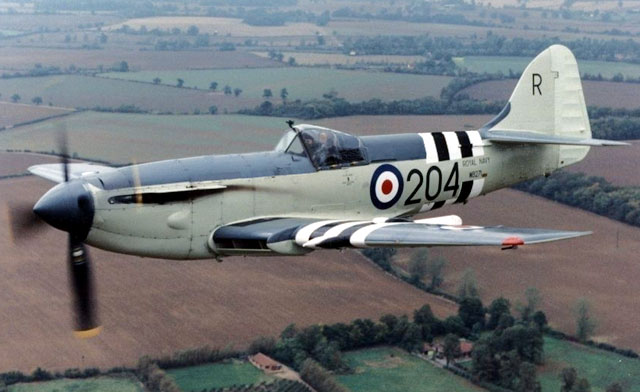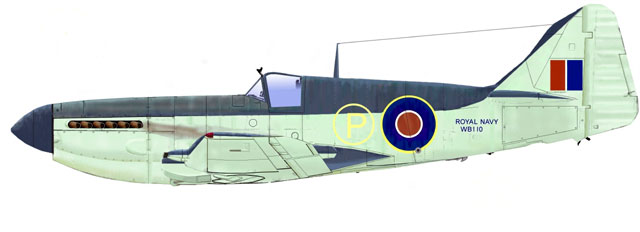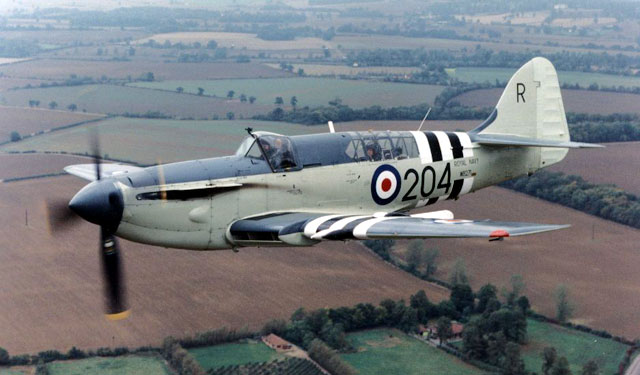|
Single Seat Firefly
A Fictional "What If"
Scenario
by Charles Knell
|
 |
|
The Royal Navy Historic
Flight's well-known Firefly Mk.V
in Korean war colours depicting its service with 812 Sqn. aboard H.M.S.
Glory |

HyperScale is proudly supported by Squadron
The Fairey Firefly was designed to a Royal navy specification as
a two-seat strike fighter, production following on from the company's previous
model, the Fulmar.
Initially conceived to use a Rolls-Royce Merlin, the Mark I was a capable if
underpowered aircraft, which was more than able to deal with the large
land-based maritime aircraft it was expected to encounter at sea.
The AS IV was projected to be an up-rated version employing a Rolls-Royce
Griffon engine, together with a redesigned wing with squared-off tips and
incorporating a Mosquito-style cooling system with radiators set into the inner
leading edge sections, which proved to be very efficient aerodynamically.
The Mk.V was originally meant to be an incremental improvement, but in line with
contemporary practice in other countries, the Admiralty relaxed the requirement
to carry an Observer/Navigator.
As with the Merlin Mustang, the Beaufighter and the Spitfire IX, the next major
development was hurried and largely unforeseen, but produced a classic design.
In a programme that rivalled that of the Mustang/Merlin story for speed of
accomplishment, a new single seat fuselage was designed with minimum engineering
changes. With the installation of a two-stage Griffon engine developing
2100h.p., the Fleet Air Arm now had a fighter in the Spitfire class but with
twice the fuel capacity.
This proved to be perfectly suited to the long distances involved in Pacific
theatre operations. The clipped wing tips, together with the Fairey -Youngman
flap system, gave it both low-level and high altitude manoeuvrability. It also
had the ability to carry a large range of naval stores, a factor which combined
with its docile carrier handling characteristics, meant that it quickly
supplanted the problematic American Corsairs in the Pacific.
|
 |
|
Profile drawing of WC089, the
Firefly V prototype.
Note the original high 'razorback' fuselage and the late style high
camouflage demarcation |
The first batches of machines were completed with 'razorback'
fuselages, but the cut down 'bubble top' version was introduced from airframe 31
onwards.
The Firefly soldiered on after the war, and was still a valuable
asset to the U.N. when used by the British and Australians in Korea.
Little known valuable side effects of the Firefly's success were the boost it
indirectly gave to the industry in the U.K. It enabled Hawker to abandon
development of the Tempest / Sea Fury line in favour of the Sea Hawk / Hunter
family, which would not otherwise have been available at the outbreak of
hostilities in Korea, leaving the R.A.F. with no real match for the MiG 15
fighters that were encountered.
It also meant the Firebrand could be quietly dropped, allowing Blackburn to
concentrate earlier on Buccaneer development, and eventually go on to gain the
U.S. Navy attack aircraft contract.
Who knows? If it weren’t for this development we might all have been flying
American aircraft today...
|
 |
|
The real WB271
in an unmodified photograph |
Text & Images Copyright © 2002 by
Charles Knell
Page Created 07 November, 2002
Last Updated
19 April, 2004
Back to Reference Library
|
Home |
What's New |
Features |
Gallery |
Reviews |
Reference |
Forum |
Search